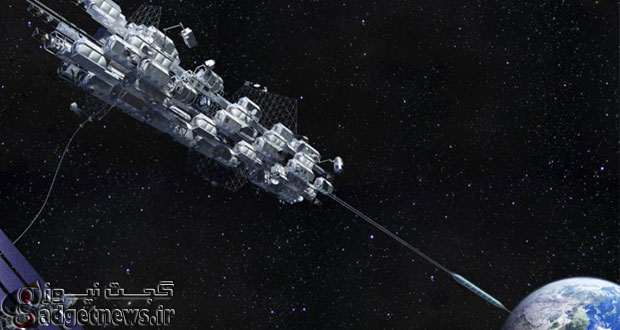شرکت ژاپنی اوبایاشی (obayashi) وعده داد تا سال 2050 آسانسوری برای حمل مسافر و بار راه اندازی خواهد کرد.شرکت ژاپنی اوبایاشی پروژه آسانسور فضایی خود را تا سال 2050 راه اندازی خواهد کرد. این آسانسور تا ارتفاع 96 هزار کیلومتری با استفاده از موتور دارای نیروی محرکه مغناطیسی بالا خواهد رفت .
هدف شرکت از احداث این آسانسور حمل و نقل مسافرین و بار با کمترین هزینه عنوان شده است. آسانسور فضایی ظرفیت 30 نفری داشته و این مسافرت 7 روز طول خواهد کشید.
این شرکت اعلام کرده این کار از طریق فناوری نانو کربن امکان پذیر است و تا سال 2030 کابلهای نانو لوله را برای این منظور تولید خواهند کرد .
این شرکت همچنین اعلام کرده مقاومت کششی این نوع از کابل تقریبا 100 برابر قوی تر از فولاد است . معمولا هزینه ارسال محموله های فضایی چیزی در حدود 22000 دلار است که با استفاده از آسانسور فضایی شرکت Obayashi این هزینه نزدیک به 200 دلار خواهد بود .
بنابر اعلام مهندسان طراح برای شروع هنوز محدودیتهای فراوانی وجود دارد که امید میرود با سرمایه گذاری و پیشرفت در زمینه نانوتکنولوژی کربن برای تولید مصالح مورد نیاز این وعده در سال 2050 تحقق یابد.
منبع : cnet
Japanese company plans space elevator by 2050
Japanese company plans space elevator by 2050
Japan’s giant construction company, Obayashi Corporation, has announced that it plans to build an elevator into space by the year 2050.
Researchers heading into space in the not-too-distant future could be travelling by elevator rather than rocket if Japanese construction giant Obayashi Corporation has its way. The company announced two years ago that it has the capacity to build a space elevator — and have it up and running by the year 2050.
Speaking to the Australian Broadcasting Corporation this month, the company said that the elevator would reach 96,000km (59,652 miles) into space (for reference, space lies beyond the Kármán Line, at an altitude of 100km, the International Space Station is 330km, and the moon is 384,400km from Earth), and use robotic cars powered by magnetic linear motors (maglev, as seen in high-speed rail lines around Asia and Europe) to ferry cargo and humans to a new space station.
All this, the company said, can be achieved because of carbon nanotechnology.
“The tensile strength is almost a hundred times stronger than steel cable so it’s possible,” said Obayashi research and development manager Yoji Ishikawa. “Right now we can’t make the cable long enough. We can only make 3-centimetre-long nanotubes but we need much more… we think by 2030 we’ll be able to do it.”
Teams around Japan are working on logistics problems associated with the elevator. A team at Kanagawa University, for example, is working on the problems associated with the robotic cars: how to ascend at varying altitudes and how to brake. If the project is successful, it could massively cut the cost and danger associated with space trips: cargo usually costs around $22,000 per kilogram via shuttle; using Obayashi’s space elevator, the cost would be closer to $200, the company said.
Obayashi is not the only company working on the feasibility of a space elevator, which could provide cheap solar power, provide a hub for space exploration and boost space tourism. In 2012, former NASA contractor Michael Laine launched a Kickstarter to raise funds to research the feasibility of a lunar space elevator, raising $110,353.
Building a space elevator, however, will likely require an international effort, and the International Space Elevator Consortium is already attempting to coordinate efforts.
“I don’t think one company can make it, we’ll need an international organisation to make this big project,” Ishikawa agreed.
 گجت نیوز آخرین اخبار تکنولوژی، علم و خودرو
گجت نیوز آخرین اخبار تکنولوژی، علم و خودرو 






